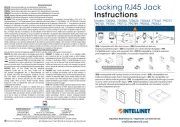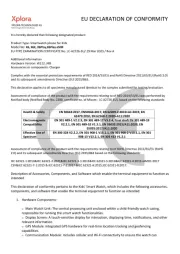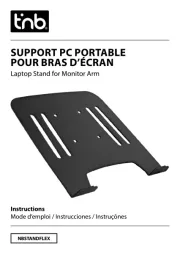Omiindustriies Cascading Register Handleiding
Omiindustriies
Niet gecategoriseerd
Cascading Register
Bekijk gratis de handleiding van Omiindustriies Cascading Register (11 pagina’s), behorend tot de categorie Niet gecategoriseerd. Deze gids werd als nuttig beoordeeld door 74 mensen en kreeg gemiddeld 4.3 sterren uit 37.5 reviews. Heb je een vraag over Omiindustriies Cascading Register of wil je andere gebruikers van dit product iets vragen? Stel een vraag
Pagina 1/11


The Cascading Register from omiindustriies is a source of pseudo-random voltages and gates
using an eight-bit shift register. It takes inspiration from digital shift registers, runglers, linear
feedback shift registers (LFSR), and analog shift registers.
Quick start guide
Plug the Cascading Register into your Eurorack power supply, making sure the power is off and
the red stripe indicating -12V is facing down. Turn on the
power supply.
When you first power on the module, all of the blue LEDs
will be on or off. Pressing the at the bottom ofSeed button
the module or patching a gate signal into the willData input
add new data into the register, and you should see the lights
begin to move from top to bottom. Don’t be surprised if the
rate isn’t steady, as the third CV output modulates the
frequency of the internal clock oscillator. Now you’re free to patch the Cascading Register to
other parts of your Eurorack system.
Try inputting different gate signals into the or it from an external clock sourceData input clock
such as a clock divider. Use the three stepped CV outputs to modulate parameters such as
pitch or timbre on an oscillator and use the gate signals to provide timing signals to initialize an
envelope or play a sample. Now that you have that going, let’s take a look under the hood and
explore the module more in-depth

The Cascading Register is the continuation of ideas put forward with the first omiindustriies
module, the Dual Digital Shift Register (DDSR). This module looked to Rob Hordijk’s famous (or
infamous) circuit at the heart of the Benjolin and Blippoo Box, the Rungler. But before we dive
into the specific implementation of historic shift registers, we must look at how they actually
work.
Shift registers in detail
Digital Shift Registers
A shift register has a clock input and a data input. In the case of digital shift registers, the data
input is a binary input with only two states, on or off. On the rising edge of a timing/clock signal
(typically a gate or trigger signal) greater than 0.5V at the , the shift register looks atclock input
the data input. It takes the state of the signal present at the data input and puts it into the first
stage of the register, (ØØ). In this case, it’s an eight-bit shift register, meaning it has eight
stages, zero-indexed from ØØ to Ø7. If the signal present at the data input is above 0.5V, it
moves a high signal into the first stage (ØØ), and if it’s low, it moves a low state into the first
stage. Additionally, on every clock pulse, whatever data is in the first stage moves to the second
(Ø1), whatever is in the second stage moves to the third (Ø2), and so on and so forth. When a
bit of information reaches the final stage, Ø7, the data is shifted out of the register.
Product specificaties
| Merk: | Omiindustriies |
| Categorie: | Niet gecategoriseerd |
| Model: | Cascading Register |
Heb je hulp nodig?
Als je hulp nodig hebt met Omiindustriies Cascading Register stel dan hieronder een vraag en andere gebruikers zullen je antwoorden
Handleiding Niet gecategoriseerd Omiindustriies

21 Juni 2023

20 Juni 2023

16 Juni 2023
Handleiding Niet gecategoriseerd
- ESX
- Cropico
- Austral
- Tonar
- XO
- Peltor
- Peterson
- Clean Paper
- Avantree
- EQ Acoustics
- UNiKA
- SilverStone
- ProLights
- MGL Avionics
- Klarstein
Nieuwste handleidingen voor Niet gecategoriseerd

16 September 2025

16 September 2025

16 September 2025

16 September 2025

16 September 2025

16 September 2025

16 September 2025

16 September 2025

16 September 2025

16 September 2025